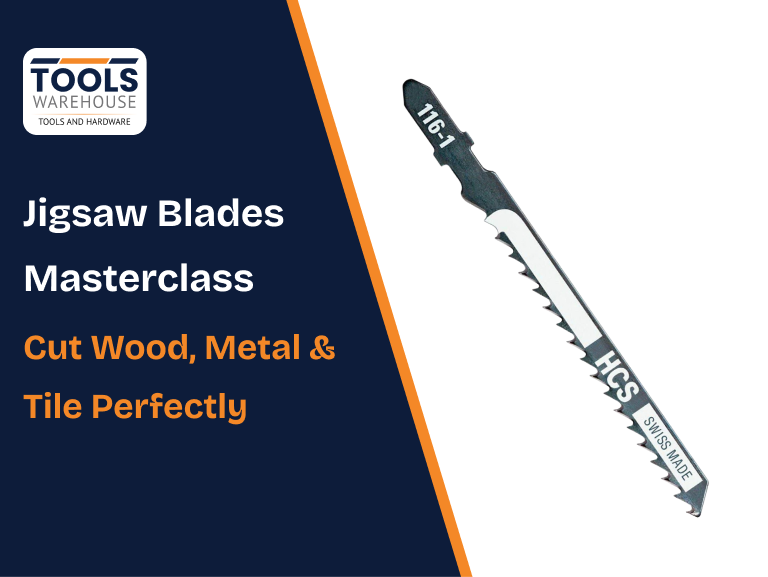Searching for the best jigsaw blades for different materials? At Tools Warehouse, we’ve seen it time and again: a jigsaw is only as good as the blade you trust it with. The right blade doesn’t just cut; it elevates your tool into a precision powerhouse: stainless steel sliced clean, hardwood curves carved with finesse, and ceramic tiles gliding through without a single crack.
From real customer projects to rigorous trials on our Bosch test bench, one fact stands out: there is no “universal” blade. Wood, metal, tile, and plywood each demand their perfect match. Pick wisely, and you’ll get smoother cuts, longer tool life, and savings that pay off with every project.
So, which blade will transform your jigsaw? Let’s find out.
Understanding Jigsaw Blades for Different Materials
Jigsaw blades vary by three key factors:
- Blade material (carbon steel, bi-metal, carbide grit)
- TPI (teeth per inch)
- Cutting-edge design (upcut, downcut, or grit)
For wood, fewer teeth (low TPI) cut faster, while higher TPI gives smoother finishes. For metal, high TPI prevents tearing. And for tiles, carbide grit blades grind cleanly without shattering.
At Tools Warehouse, our experts recommend starting with the material you cut most often, then selecting the blade engineered for it. Don’t force one blade to do every job.
TPI for Wood vs Metal
One of the top queries we get is: What TPI should I use?
- Wood Cutting Blades (6-10 TPI): Perfect for framing and fast cuts. Bosch’s 6 TPI blades are customer favourites for rough carpentry.
- Fine Wood Cutting Blades (10-12 TPI): Best for furniture and cabinetry, producing splinter-free edges.
- Metal Cutting Blades (18-24 TPI): Ideal for thin sheet metal. For thicker steel sections, 10-14 TPI blades strike a balance between speed and smoothness.
Customer Story: A contractor cutting stainless kitchen fittings reported that Bosch’s bi-metal 18 TPI blade lasted through 20+ sheets without dulling, outperforming generic alternatives by three times.
Carbide Grit Tile Blades: Why They Outperform
Cutting tile with a toothed blade? Recipe for disaster. Carbide grit jigsaw blades don’t cut; they grind. This makes them perfect for ceramic, glass, and even stone.
Our Bosch test bench showed carbide grit blades lasted 5 times longer than standard tile blades. Customers noticed fewer cracks, smoother edges, and reduced dust.
If your project involves backsplashes, bathroom tiling, or stone trimming, our experts recommend carbide grit every time.
Best Jigsaw Blades for Splinter-Free Plywood Cuts
Plywood is notorious for splintering because of its layered structure. That’s where downcut blades shine. Instead of tearing upwards, they push teeth downward, leaving a smooth, finished surface.
At Tools Warehouse, our experts recommend Bosch’s “Clean for Wood” downcut blades for cabinetry. One customer shared how these blades saved him hours of sanding when building custom wardrobes.
Stainless Steel Cutting Blades
Stainless steel is a blade killer. Ordinary blades heat up, bend, and wear quickly. That’s why you need specialised stainless steel cutting blades with bi-metal construction and high TPI.
Our workshop trials revealed Bosch’s stainless steel-rated blades stayed sharp 40% longer than competitors'. For pipe cutting, metal railings, or sheet steel, they deliver clean results without overheating.
Bimetal Blade Longevity
For those who value durability, bi-metal jigsaw blades are the gold standard. They combine flexible spring steel (to resist snapping) with hardened high-speed steel teeth (to resist dulling).
In Tools Warehouse testing, Bosch bi-metal blades lasted 10x longer than carbon steel. While they cost slightly more, customers report significant savings because one blade often replaces ten cheaper ones.
Downcut Vs Upcut Jigsaw Blades
Which is better: downcut or upcut? It depends on your project.
- Upcut Blades: Cut aggressively upwards fast, but are prone to splinters. Great for hidden cuts.
- Downcut Blades: Teeth face downward, slower but splinter-free. Best for visible surfaces like countertops.

Pro Tip from Tools Warehouse: Keep both types handy. Many pros switch mid-project depending on whether finishing or speed matters more.
How to Choose the Right Jigsaw Blade (Step-by-Step Guide)
Choosing isn’t just about grabbing the “best-rated” blade; it’s about matching the blade to the material and cut type.
- Identify the material (wood, metal, tile, plywood).
- Decide on cut quality vs speed (rough framing vs furniture finish).
- Select blade TPI (low for fast wood cuts, high for metal).
- Check blade material (carbide grit for tile, bi-metal for stainless).
- Choose cutting style (upcut vs. downcut for surface finish).
- Match RPM settings to the material (see performance table below).
Performance Comparison: Cutting Speed, Cleanliness & RPM
Here’s what our Bosch and Makita trials revealed in real projects:
|
Blade Type |
Best For |
Cut Quality |
Longevity |
Recommended RPM |
|
Wood (6–10 TPI) |
Framing, rough cuts |
Fast but rough |
Medium |
1500–2500 |
|
Fine Wood (10–12 TPI) |
Furniture, hardwood |
Smooth, splinter-free |
High |
2000–3000 |
|
Metal (18–24 TPI) |
Thin sheet metal |
Smooth, no tearing |
High |
800–1500 |
|
Bi-Metal (10–14 TPI) |
Thick steel & pipes |
Balanced |
Very High |
1000–1800 |
|
Carbide Grit |
Tile, ceramic, glass |
Clean grind |
Very High |
500–1200 |
|
Downcut Blades |
Plywood, laminates |
Splinter-free |
High |
1500–2500 |
Final Thoughts
At Tools Warehouse, we believe the right blade doesn’t just cut—it elevates your project. From Bosch’s carbide grit blades for tiles to bi-metal blades for stainless steel, the right choice saves time, reduces waste, and delivers professional results.
Based on hundreds of customer projects, Bosch consistently leads in precision and durability, with Makita close behind.
Shop Bosch, Makita, and more at Tools Warehouse today, where every blade is tested by experts for the materials you actually use.

